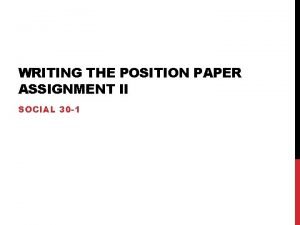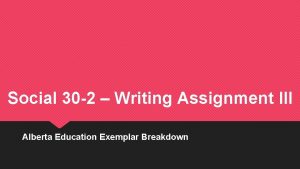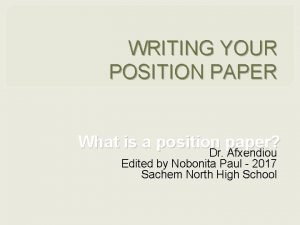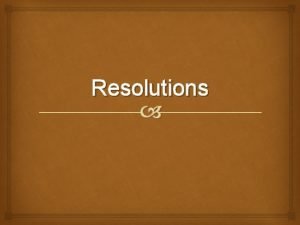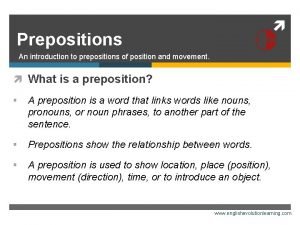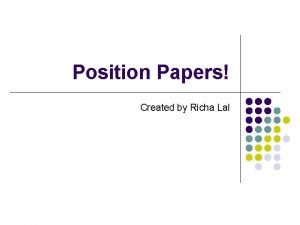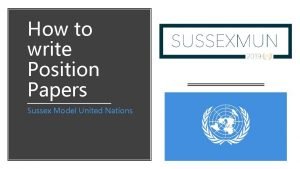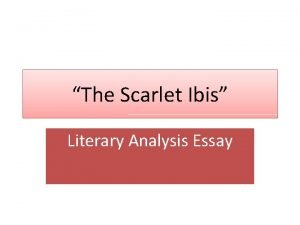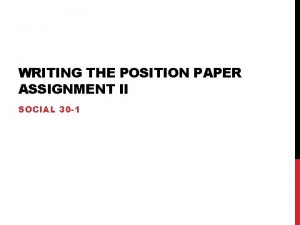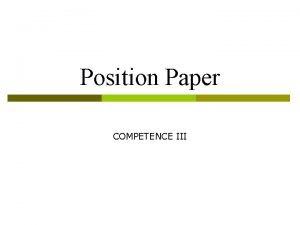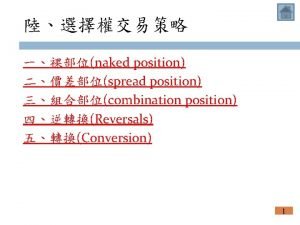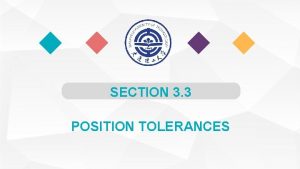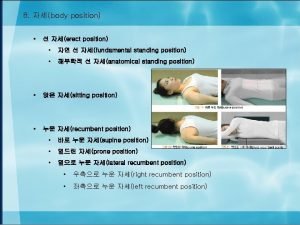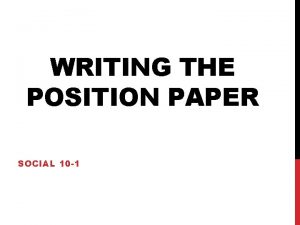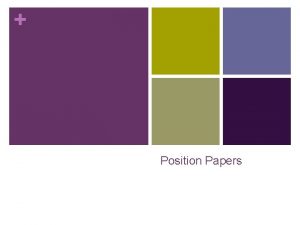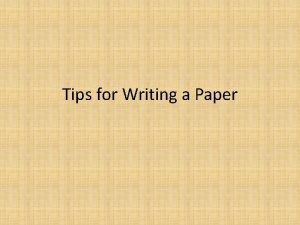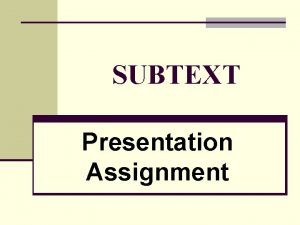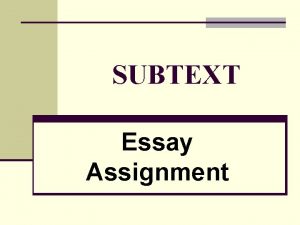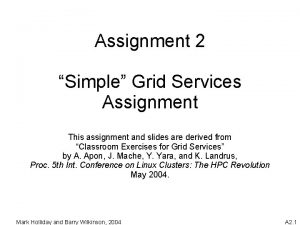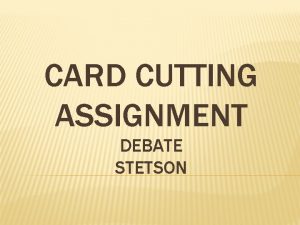WRITING THE POSITION PAPER ASSIGNMENT II SOCIAL 30






















- Slides: 22

WRITING THE POSITION PAPER ASSIGNMENT II SOCIAL 30 -1

OVERVIEW OF A POSITION PAPER §The Source will always be a quote that reflects a particular perspective. §Regardless of the source, you will ALWAYS be asked the same question: TO WHAT EXTENT SHOULD WE EMBRACE THE IDEOLOGICAL PERSPECTIVE(S) REFLECTED IN THE SOURCE? §Your position (thesis) will be a guide for your entire essay. It will be the focus of every argument you present and must connect to the source. Your evidence is used to support your thesis. §Support your position by providing evidence from your knowledge and understanding of the topic (this is where you insert the material you learn in class). §This essay should be written in a formal manner. Therefore, you must have a minimum of five to six paragraphs.

ASSIGNMENT 2 ‘MUST HAVES’ You have four tasks in Assignment II: 1) Analyze the source 2) Choose a position a) b) c) Fully embrace (agree) Not embrace (disagree) Partially embrace (in the middle) 3) Provide arguments for your position 4) Provide evidence for your arguments

ANALYZING / INTERPRETING THE SOURCE For all of the source you need to: 1) Analyse and clarify its meaning 2) Identify the ideological perspective the source represents 3) Identify who or what groups (be selective) would advocate the perspective presented in the source 4) Identify who or what groups (be selective) would counter the perspective presented in the source

STEP 1 UNDERSTAND & INTERPRET THE SOURCE Underline the key words in the source: “Society achieves its finest expression through the self-interest and freedom of individuals. When we adopt these principles, we will lessen the need for government to interfere in our lives. ”

STEP 1 (ANSWER) UNDERSTAND & INTERPRET THE SOURCE Underline the key words in the source: “Society achieves its finest expression through the self-interest and freedom of individuals. When we adopt these principles, we will lessen the need for government to interfere in our lives. ”

STEP 2 UNDERSTAND & INTERPRET THE SOURCE Clarify the meaning of the key words. What does “self-interest” mean? What does “freedom” of the individual mean? What does government “interference” mean or look like? Self-interest Freedom Government interference

STEP 3 UNDERSTAND & INTERPRET THE SOURCE Underline the words in the source that illustrate the writer’s tone & perspective: “Society achieves its finest expression through the self-interest and freedom of individuals. When we adopt these principles, we will lessen the need for government to interfere in our lives. ”

STEP 3 (ANSWERS) UNDERSTAND & INTERPRET THE SOURCE Underline the words in the source that illustrate the writer’s tone & perspective: “Society achieves its finest expression through the self-interest and freedom of individuals. When we adopt these principles, we will lessen the need for government to interfere in our lives. ”

STEP 4 UNDERSTAND & INTERPRET THE SOURCE Clarify the meaning of the words representing the writer’s tone/perspective. Society’s finest expression Lessen the need Adopt Interfere

STEP 5 POINTS TO PONDER 1. 2. 3. 4. 5. 6. How does society achieve its finest expression? How/ when and to what extent do self-interest and individual freedom enable society to achieve greatness? When is government intervention necessary? When/how does government interference imply conflict? When/how does self interest and freedom imply conflict? What are the potential implications/consequences of individuals pursuing self interest & freedom?

STEP 6 OVERALL MEANING OF SOURCE After deconstructing the source (key words/tone), what is the overall meaning of the source? “Society achieves its finest expression through the self-interest and freedom of individuals. When we adopt these principles, we will lessen the need for government to interfere in our lives. ”

STEP 7 EXAMINING POSSIBLE POSITIONS Using a spectrum/t-chart come up with supporting arguments for the possible positions. Agree with the Source Partially Agree with the Source Disagree with the Source

STEP 7 EXAMINING THE POSSIBLE POSITIONS (ANSWERS) Using a spectrum/t-chart come up with supporting arguments for the possible positions. Agree with the Source • • Self-interest- benefit the individual and the group (result of hard work) Freedom (pursue success) Economic freedom (economic freedom) Individual rights & freedoms- preserved & higher quality of life. Partially Agree with the Source Disagree with the Source • • No government interferencegreed- societal abuses No government interferencemarket will be unstable Government involvementprovides safety & stability for society in times of crisis (surveillance, terrorism, C-51) Government needs to be involved to ensure collective responsibility/ cooperation (health care/EI/CPP).

STEP 8 CHOOSING A POSITION After looking at the t-chart, identify the 3 strongest arguments and then choose your position. • Fully agree with the Source • Fully disagree with the Source • Partially agree with the Source

STEP 8 CREATE YOUR THESIS A good thesis is not only a debatable claim, but also suggests the structure of the paper. Your thesis statement should: • State your position on the source • Fully agree with the Source • Fully disagree with the Source • Partially agree with the Source • Back up your position using reasons/arguments (3) that you came up with.

INTRODUCTORY PARAGRAPH Analysis of the source- this is where you identify any bias in the source and then you keep to answer the following questions: • What does the source mean? Your interpretation of the source needs to be comprehensive. • Who or what groups would advocate the perspective present in the source? Why? • What motivation would the author or cartoonist have for showing you this information? • Who or what groups would counter the perspective present in the source? Why? Transition- moves you from the analysis of source to thesis that you chose. Thesis statement- Determine whether you agree, disagree or partially agree with the source. Your thesis will begin like one of the three following: • You completely agree with the source: “The perspective of the source should be embraced” • You completely disagree with the source: “The perspective of the source should not be embraced” • You partially agree or disagree with the source: “The source should only be partially embraced” or “To an extent, the source should/should not be embraced”

MENTOR TEXT: INTRODUCTORY PARAGRAPH The source as presented is reflective of a position most consistent with classical liberalism. The writer’s inclusion of the liberal principles of self-interest and individual freedom speak to the idea that government intervention is not welcome, and in fact, is actually discouraged. The writer’s contention that government involvement is deemed as a form of interference, is mitigated by the admission that there is some government presence. This encroachment would be lessened, according to the writer, if society accepts certain fundamental tenets of liberalism. Granted, the perspective reflected in the source is not as drastic as author Ayn Rand would suggest, but saying that “Society” (presumably one promoting a very right-wing agenda) achieves its “finest expression” only through the adoption of these principles is surely an exaggeration. Physiocrats such as John Stuart Mill wrote of these “perceived” benefits of a laissez-faire political and economic system in his treatise, On Liberty. Mill’s idea of a largely unfettered marketplace, along with Milton Friedman and Friedrich Hayek’s limited government model, would undoubtedly espouse the values reflected in the source. According to these theorists, self-interest is vital to the creation of a prosperous society where individuals will strive to better their own respective economic position(s) in life. At the same time, individual freedom is crucial to the maintenance of spontaneous order in economic decision-making. Conversely, proponents of a more left-wing model would cringe at this perspective. Critics would scoff at the token admission by the author that society requires a modicum of influence on the citizenry. Luminaries such as Karl Marx wrote of the societal pitfalls of unfettered capitalism in Das Kapital and The Communist Manifesto. What the author fails to recognize is the adoption of such dogma, if not restrained by government intervention and oversight, can also result in negative political, economic and social consequences. As a result, the source (as presented), should only be accepted providing that there are governmental safeguards in place to ensure economic stability, the maintenance of civil liberties, and the prevention of exploitation.

MENTOR TEXT: INTRODUCTORY PARAGRAPH The source as presented is reflective of a position most consistent with classical liberalism. The writer’s inclusion of the liberal principles of self-interest and individual freedom speak to the idea that government intervention is not welcome, and in fact, is actually discouraged. The writer’s contention that government involvement is deemed as a form of interference, is mitigated by the admission that there is some government presence. This encroachment would be lessened, according to the writer, if society accepts certain fundamental tenets of liberalism. Granted, the perspective reflected in the source is not as drastic as author Ayn Rand would suggest, but saying that “Society” (presumably one promoting a very right-wing agenda) achieves its “finest expression” only through the adoption of these principles is surely an exaggeration. Physiocrats such as John Stuart Mill wrote of these “perceived” benefits of a laissez-faire political and economic system in his treatise, On Liberty. Mill’s idea of a largely unfettered marketplace, along with Milton Friedman and Friedrich Hayek’s limited government model, would undoubtedly espouse the values reflected in the source. According to these theorists, self-interest is vital to the creation of a prosperous society where individuals will strive to better their own respective economic position(s) in life. At the same time, individual freedom is crucial to the maintenance of spontaneous order in economic decision-making. Conversely, proponents of a more left-wing model would cringe at this perspective. Critics would scoff at the token admission by the author that society requires a modicum of influence on the citizenry. Luminaries such as Karl Marx wrote of the societal pitfalls of unfettered capitalism in Das Kapital and The Communist Manifesto. What the author fails to recognize is the adoption of such dogma, if not restrained by government intervention and oversight, can also result in negative political, economic and social consequences. As a result, the source (as presented), should only be accepted providing that there are governmental safeguards in place to ensure economic stability, the maintenance of civil liberties, and the prevention of exploitation.

STEP 9 FRAMEWORK FOR BODY PARAGRAPHS Choose specific examples from your knowledge of social studies to support your argument(s). Argument #1 Argument #2 Argument #3 No government interference- will lead to greed- market will be unstable Government involvementprovides safety & stability for society (surveillance, terrorism, C-51) Government needs to be involved to ensure collective responsibility/ cooperation (health care/EI/CPP). Argument • Evidence • • Great Depression (FDR) 2008/2009 Market Crash • • Surveillance (airport security) War Measures Act/ Emergencies Act Anti-terrorism Act Patriot Act Terrorism (9/11) (C-51) • • • Health care CPP (Pensions) EI Welfare Progressive Taxation

BODY PARAGRAPHS A BODY is comprised of three things: A statement that is a reasonable, logical & can be supported (persuasive) Specific support (examples) An explanation of how the evidence supports your argument and how this proves your position & is related to the source Body Paragraphs: • The topic sentence/argument for your paragraph. Topic Sentences/arguments are NOT examples!! • Arguments must be logical & reasonable & based on at least one of these considerations: ethical/moral, environmental, political, economic, historical • Explain why your argument is true. A tip: Ask either “How? ” or “Why? ” and explain it. • Support your arguments with specific evidence that is accurate, relevant & detailed – could be historical, theoretical, or contemporary (current events) • You can provide counter-arguments and discuss why the other perspectives are wrong (REFUTATION) as long as they don’t overpower your own arguments, or confuse your reader. • All things written in your paragraph should be related and linked to the source and your thesis. • Concluding sentence should be used to relate your arguments and evidence back to the source. • REMEMBER S. E. X. (Statement(argument); Evidence; e. Xplanation (how evidence proves your argument & position)

CONCLUSION PARAGRAPH The CONCLUSION comprises three elements: • Re-statement of thesis statement (USE OTHER WORDS). • Summary of Arguments • PQRS – Choose ONE of these **End with a “Ta. Daa” statement • • Prediction Question Recommendation Statement Do NOT introduce new information in your conclusion
 Position paper assignment
Position paper assignment Ballet terms and positions
Ballet terms and positions Social 30-2 writing assignment 3
Social 30-2 writing assignment 3 Social thinking and social influence
Social thinking and social influence Social thinking social influence social relations
Social thinking social influence social relations English general paper paper 2 comprehension
English general paper paper 2 comprehension Aice general paper discursive essay
Aice general paper discursive essay Document definition
Document definition Factual knowledge in position paper
Factual knowledge in position paper Purpose of a position paper
Purpose of a position paper Position paper mun sample
Position paper mun sample Naimun position paper
Naimun position paper Global classroom position paper
Global classroom position paper Papercut sfu
Papercut sfu Adventure time
Adventure time Introduction of preposition
Introduction of preposition Position paper structure
Position paper structure Mun position paper outline
Mun position paper outline Fundamental position vs anatomical position
Fundamental position vs anatomical position Fundamental standing position
Fundamental standing position Similes in the scarlet ibis
Similes in the scarlet ibis Bucket list essay conclusion
Bucket list essay conclusion The giver narrative writing
The giver narrative writing
